Obsessive compulsive disorders
| Obsessive–compulsive disorder | |
|---|---|
 |
|
| Frequent, excessive hand washing occurs in some people with OCD | |
| Specialty | Psychiatry |
| Symptoms | Feel the need to check things repeatedly, perform certain routines repeatedly, have certain thoughts repeatedly |
| Complications | Tics, anxiety disorder, suicide |
| Usual onset | Before 35 years |
| Causes | Unknown |
| Risk factors | Child abuse, stress |
| Diagnostic method | Based on the symptoms |
| Similar conditions | Anxiety disorder, major depressive disorder, eating disorders, obsessive–compulsive personality disorder |
| Treatment | Counselling, selective serotonin reuptake inhibitors, tricyclic antidepressants |
| Frequency | 2.3% |
| Classification |
· ·
|
|---|---|
| External resources |
Obsessive–compulsive disorder (OCD) is a mental disorder where people feel the need to check things repeatedly, perform certain routines repeatedly (called "rituals"), or have certain thoughts repeatedly. People are unable to control either the thoughts or the activities for more than a short period of time. Common activities include hand washing, counting of things, and checking to see if a door is locked. Some may have difficulty throwing things out. These activities occur to such a degree that the person's daily life is negatively affected. Often they take up more than an hour a day. Most adults realize that the behaviors do not make sense. The condition is associated with tics, anxiety disorder, and an increased risk of suicide.
The cause is unknown. There appear to be some genetic components with both identical twins more often affected than both non-identical twins. Risk factors include a history of child abuse or other stress inducing event. Some cases have been documented to occur following infections. The diagnosis is based on the symptoms and requires ruling out other drug related or medical causes. Rating scales such as the Yale–Brown Obsessive Compulsive Scale can be used to assess the severity. Other disorders with similar symptoms include anxiety disorder, major depressive disorder, eating disorders, tic disorders, and obsessive–compulsive personality disorder.
Treatment involves counselling, such as cognitive behavioral therapy (CBT), and sometimes medication, typically selective serotonin reuptake inhibitors (SSRIs). CBT for OCD involves increasing exposure to what causes the problems while not allowing the repetitive behavior to occur. While clomipramine appears to work as well as SSRIs, it has greater side effects.Atypical antipsychotics may be useful when used in addition to an SSRI in treatment-resistant cases but are also associated with an increased risk of side effects. Without treatment, the condition often lasts decades.
...
Wikipedia
